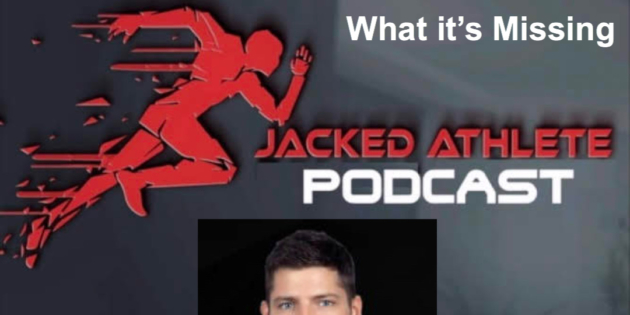http://traffic.libsyn.com/jackedathlete/David_Grey_Podcast_MP3.mp3
“Can we get everything to do its own job… so no area is being overloaded.”
“If I have an Achilles Tendinopathy, and I just do calf raises, then the presumption then is: I have an Achilles Tendinopathy because my calves are weak.”
“It doesn’t make sense for someone to say ‘You have a weak Glute Med’… why is that side weak and the other side isn’t?”
“The shape of my foot dictates that… as soon as I heel strike, and then my foot hits the floor, my knee should be bending towards my big toe.”
Jumping and knees in: “Without one, there isn’t another. So if we’re saying you can’t internally rotate then we’re also saying, really, you can’t externally rotate.”
One or more things that are usually missing for athletes:
- A posterior tilt
- The ability to get their ribs down
- And the ability to pronate and supinate the foot
“A lot of times in the gym, we are training people to have a pelvis that doesn’t move and a femur that just rotates under the pelvis.”
Back Squats: “As soon as I lift my ribs, my pelvis will do the opposite thing… now I have quads at the front that are shortened… but now I have a hamstring in the back that’s lengthened.” Quads have a good length-tension relationship to produce force, hamstrings do not.
Nordics and RDLs with an anterior tilt: “It’s easy to feel your hamstrings when you go into an anterior tilt cause they’ve just been put on stretch… Can you feel them from a more neutral position? That’s when you know you’re doing a good job.”
“For someone that has knee pain, we can do all the ISOs in the world and yes, my knee will feel better. But I want to get all my athletes to the point where actually, the tendon is not being overloaded in the first place.”
“Simply assess someone standing up and ask them to posteriorly tilt their pelvis for you and you’ll see all kinds of things that are not a posterior tilt.”
When the foot hits the ground during sprinting: “The calf and the hamstring are going to cocontract together to keep the knee in an isometric, which keeps the knee safe… and that’s what allows then the glute to push me forward to get hip extension.”
When things go wrong: “If I’m very very quad dominant… if my calf and my hamstring can’t cocontract well enough together to keep my knee in an isometric, then the quad will extend the knee too soon. If I straighten my knee too early, then I’m starting to go into hip extension, but that’s a hip extension by the quad pushing my knee back rather than my glute pushing my hip forward.”
“Good running is hip extension before knee extension.”
“Hip extension before knee extension requires an isometric at the knee which requires a calf and a hamstring to cocontract with the quad rather than a quad overpowering the calf and hamstring.”
Terminal Knee Extensions: “Never.” “They’re teaching their brain how to hip extend by using their quads.”
Intermuscular coordination: “As soon as we try to get those two muscles (calf and hamstring) to communicate well together, a lot of people who have knee pain will cramp (in either the calf or the hamstring).”
“If my brain thinks that I have an inability or a poor ability to cocontract around a certain joint… maybe it puts pain there instead as a protective mechanism.”
“When we grip the toes, your transverse arch will actually pop up off the floor, so I’m not training the arch of my foot anymore.”
“If someone has a more proximal problem (ribcage or pelvis), then I’m probably more inclined to get them more on their heels.”
“Everything is gait… even as we train in the weightroom. We’re either making people better at gait or worse at gait. They’re getting better at running or they’re getting worse at running and jumping and walking.”
People focused on belly breathing: “They’re the people I see that have, by far, the worst breathing mechanics.”
“If I have someone with knee pain and I see them belly breathing and they can’t expand into different parts of their rib cage, I will not start with anything else until they can do that.”
“If you’re belly breathing, you’re going into an anterior tilt on every single inhale.”
Improving the ISO Lunge:
- Don’t be as anterior tilted. Get the hips to tuck under.
- Keep the ribs down. Get abs and obliques on.
- Center of mass a little bit more over the front foot rather than being straight directly in between both legs.
- Really long exhalations in those positions.
- Hamstrings will be in a better length-tension relationship.
- “I’m starting to change movement habits in a position that I’m training anyway.”
Single-leg Glute Bridge to get cocontractions of calf and hamstring:
The above exercise: “I like my athletes to be able to hold this for 45-60 seconds.”
“If we can start to go towards more oscillation stuff… we start to drive the reflexive properties of the muscles to have to contract very quickly… that’s what drives the cocontractions that really protect something like a knee and start to take pain away.”
David Grey Rehab on Instagram



